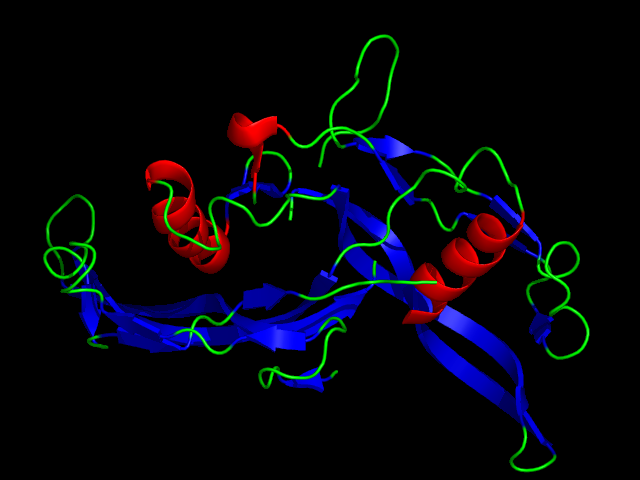Activin
| inhibin, beta A (activin A, activin AB alpha polypeptide) | |
|---|---|
 The Activin dimer, from 2ARV.pdb | |
| Identifiers | |
| Symbol | INHBA |
| Entrez | 3624 |
| HUGO | 6066 |
| OMIM | 147290 |
| RefSeq | NM_002192 |
| UniProt | P08476 |
| Other data | |
| Locus | Chr. 7 p15-p13 |
| inhibin, beta B (activin B, activin AB beta polypeptide) | |
|---|---|
| Identifiers | |
| Symbol | INHBB |
| Entrez | 3625 |
| HUGO | 6067 |
| OMIM | 147390 |
| RefSeq | NM_002193 |
| UniProt | P09529 |
| Other data | |
| Locus | Chr. 2 cen-q13 |
|
WikiDoc Resources for Activin |
|
Articles |
|---|
|
Most recent articles on Activin |
|
Media |
|
Evidence Based Medicine |
|
Clinical Trials |
|
Ongoing Trials on Activin at Clinical Trials.gov Clinical Trials on Activin at Google
|
|
Guidelines / Policies / Govt |
|
US National Guidelines Clearinghouse on Activin
|
|
Books |
|
News |
|
Commentary |
|
Definitions |
|
Patient Resources / Community |
|
Directions to Hospitals Treating Activin Risk calculators and risk factors for Activin
|
|
Healthcare Provider Resources |
|
Causes & Risk Factors for Activin |
|
Continuing Medical Education (CME) |
|
International |
|
|
|
Business |
|
Experimental / Informatics |
Editor-In-Chief: C. Michael Gibson, M.S., M.D. [1] Phone:617-632-7753
Overview
Activin is a peptide that enhances FSH synthesis and secretion and participates in the regulation of the menstrual cycle. It does the opposite as inhibin. Many other functions have been found to be exerted by activin, including their roles in cell proliferation, differentiation, apoptosis[1], metabolism, homeostasis, immune response, wound repair[2], and endocrine function
Like inhibin (and AMH) activin belongs to TGF-β superfamily.
Structure
Activin contains two beta subunit that are identical to the two beta subunits (A or B) of inhibin, allowing for the formation of three forms of activin: A, AB, and B.
They are linked by a single covalent disulfide bond.
Function
Activin is produced in the gonads, pituitary gland, placenta and other organs:
- In the ovarian follicle, activin increases FSH binding and FSH induced aromatization. It participates in androgen synthesis enhancing LH action in the ovary and testis. In the male, activin enhances spermatogenesis.
- Activin is strongly expressed in wounded skin, and overexpression of activin in epidermis of transgenic mice improves wound healing and enhances scar formation. Its action in wound repair and skin morphogenesis is through stimulation of keratinocytes and stromal cells in a dose-dependent manner.[3]
- Activin also regulates the morphogenesis of branching organs such as the prostate, lung, and especially kidney. Activin A increased the expression level of type I collagen suggesting that activtin A acts as a potent activator of fibroblasts.
Mechanism
As with other members of the superfamily, activins interact with two types of cell surface transmembrane receptors (Types I and II) which have intrinsic serine/threonine kinase activities in their cytoplasmic domains.
Activin binds to the Type II receptor and initiates a cascade reaction that leads to the recruitment, phosphorylation, and activation of Type I activin receptor. This then interacts with and then phosphorylates Smad2 and Smad3, two of the cytoplasmic Smad proteins.
Smad3 then translocates to the nucleus and interacts with Smad4 through multimerization, resulting in their modulation as transcription factor complexes responsible for the expression of a large variety of genes.
References
- ↑ Chen YG, Wang Q, Lin SL, Chang CD, Chung J, and Ying SY. Activin Signaling and its Role in Regulation of Cell Proliferation, Apoptosis and Carcinogenesis. Exp Biol Med. 2006; 231: 534-544.
- ↑ Sulyok S, 20 M, Alzheimer C, Werner S. Activin: an important regulator of wound repair, fibrosis, and neuroprotection. Molecular and Cellular Endocrinology. 2005; 225: 126-132.
- ↑ Bamberger C, Schärer A, Antsiferova M, Tychsen B, Pankow S, Müller M, Rülicke T, Paus R, and Werner S. Activin Controls Skin Morphogenesis and Wound Repair Predominantly via Stromal Cells and in a Concentration-Dependent Manner via Keratinocytes. American Journal of Pathology. 2005; 167 (3): 733-741.
External links
- Template:EMedicineDictionary
- Activin at the US National Library of Medicine Medical Subject Headings (MeSH)